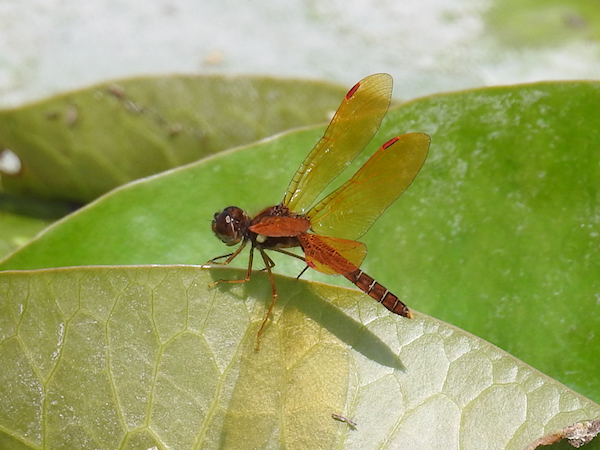It was only six weeks ago that I last added a new species to the Eagleson storm water ponds ode list, the River Jewelwing that mysteriously showed up for one day back on June 10, 2023. I wasn’t expecting to find another new species so soon, but that is exactly what happened when I went for a walk there this afternoon. My goal was to look for the diminutive Eastern Amberwings, a species that I would have looked for earlier in the month had I not been in Nova Scotia. This colony first showed up in 2017 and its numbers have been increasing in the southern ponds over the last six years. I was happy to find four males perching on the lily pads on my visit; it appears they are still thriving here.

I saw Orange Bluets here for the first time this year on July 3, 2023, and I was hoping to find a few close enough to the shore to get a good photo. This is the second season that I’ve confirmed their presence here, and I was disappointed not to find any on this visit.
I saw Blue Dashers here for the first time this year on July 7, 2023; this is also only the second year that I’ve seen them here, and I counted at least eight of them around the two southern-most ponds. They are so beautiful and colourful when fresh – I can’t imagine ever becoming so used to them that I don’t want to stop and admire them, especially when they are sitting on a such a lovely perch.

I saw a male and female Common Whitetail flying over the pond together; the female was ovipositing. A White-faced Meadowhawk and a Band-winged Meadowhawk were nice to see, though the Band-winged Meadowhawk didn’t stick around long enough for photos. I’ve been keeping an eye out for Saffron-winged Meadowhawks, a species that was common here in 2020 but has been diminishing in numbers ever since – I only found two in 2021 and one in 2022. I didn’t see any on this walk, making me wonder if the population has died out. Its season lasts until September, so it is not too late to keep looking for this species.
A Slender Spreadwing was the only other odonate of interest, other than the Eastern Forktails that are usually too numerous to count.
A small, orange-coloured moth caught my attention, and when it landed on a daisy I recognized it from one I had photographed in my own yard a few years ago. The aptly named Orange Mint Moth caterpillars feed on Bee Balm (Monarda), a member of the mint family which I grow in my backyard.

I finished my walk with a loop around the Hope Side pond, stopping at the bridge where I took a moment to scan the water toward the overpass. I’ve seen muskrats swimming and dragonflies flitting among the vegetation here, and almost immediately something small and black fluttering in the tunnel formed by the cattails toward the bridge. When I got my binoculars on it I saw a male Ebony Jewelwing sitting in the sun!

Ebony Jewelwings are usually found at woodland streams, preferring those with rapids although they may be found at shaded, slow-moving streams as well. The area it was inhabiting at the Eagleson ponds is no more than a shallow channel that drains water from the ponds into a narrow waterway running alongside a patch-work of fields before entering the Jock River at Terry Carisse Park. But since a River Jewelwing has already found its way up here perhaps I shouldn’t be surprised that this Ebony Jewelwing had followed. This is ode species #36 for the ponds – a terrific number for such a small area and limited habitat.
I wonder what #37 will be?